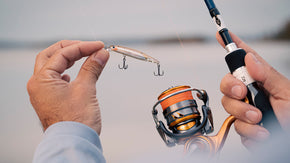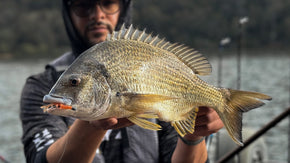Posted 13th June 2025
Winter beach fishing guide


By Robert Thornton
Around much of the country, winter is a favourite time to hit the beach. While the reasoning for this varies from region to region, it’s clear that a lot of the best beach catches come when the mercury is low and the days are at their shortest for the year.
Given how productive winter is in the surf, these months are an excellent time for anyone interested to try beach fishing for the first time. Before that maiden trip is even over, I’m sure you’ll already be planning your next session – winter beach fishing can be quite addictive!
This article is more than a simple ‘how to go beach fishing’ for budding beach fishers – for that, you can get some basic info here.
In this blog, we’ll look at why winter is the perfect time to start beach fishing, what you’ll need to get going, and a few tips to see you through the season!

WINTER WONDERS
When we talk about beach fishing, we refer to sandy coastline with breaking ocean swell. Environments like this are constantly changing with the action of the waves, creating formations in the topography that dictate where fish will be. The stretches of coast from southern Queensland to North East Victoria, and the South and West coasts ranging from Western Victoria to about Exmouth in Western Australia, fit this description for the most part. ‘Beaches’ in other parts of the country are denied consistent swell by reefs, islands and other landmarks and geographical features that keep the wave heights to a minimum and see the shape of the coastline changing relatively little.
East Coast
From southern Queensland down to about Sydney, winter is the time when seas are at their calmest. This period is characterised by bright, sunny days and low wind, and on these relatively steep ocean beaches it’s a great time to soak baits or cast lures to sand whiting, yellowfin bream, flathead and swallowtail dart. These species prefer clean water to feed, and in summer when the seas are bumpy and the water is murkier, they tend to move elsewhere.
Tailor and Australian salmon like to feed closer to shore when the swell gets up on the East Coast, with larger gutters, known as ‘barrels’, worth a go in these conditions.
Another bonus of winter in this part of the world is the seasonal mullet run in early winter. While sea mullet themselves aren’t particularly sought-after for recreational anglers, the mulloway that hungrily shadow them certainly are! Nighttime sessions can deliver exceptional results on the beach, though I must warn you that chasing mulloway in the surf is seldom easy, and many diehards simply accept the inevitability of many fishless trips between captures.
South Coast
From the Far South Coast of NSW and around to where South Australia meets the WA border, winter is a little different. In this part of the world, the bulk of annual rainfall occurs in the cooler months, and storms are a consistent feature.
While this doesn’t sound particularly inviting, winter is still seen as a top time for beach fishing down here. One of the main reasons is that boating is not as viable in the harsh cold and unpredictable conditions, and therefore land-based fishing is a far safer option for many anglers. A good pair of waders and a thermos full of any warm beverage is a must down south!
Additionally, the list of desirable species available from the beach is longer in winter. Aussie salmon, tailor, mulloway, silver trevally and tommy ruff don’t mind a bit of breaking swell on southern beaches, with most coastlines exhibiting a relatively shallow gradient with lots of white water. Hunters like tailor and salmon are more exposed when conditions are calm, so a bit of a bump in the swell helps them to feel more comfortable when combing these shallow beaches.
Furthermore, the increased rainfall through winter means more food is pushed out of rivers and creeks, so fishing nearby the mouths of these systems is a no brainer after heavy rain.

West Coast
Over in the west, it’s a different story again. Storms and big seas are common in winter – just as they are in the south – however the gradient on these beaches can vary a lot, even between adjoining beaches. Additionally, WA’s beaches tend to have far more underwater structure like rock, kelp and patches of gravel close to shore.
As a result, the beach fishery in the west is like no other around the country, and in all honesty, the fishing is pretty good year-round!
Species like Aussie salmon, snapper (known as ‘pink snapper’ to West Australians), Australian herring (tommy ruff), tailor, and mulloway are high on the list in winter. In autumn and the early part of winter, southern WA experiences a crazy run of jumbo Aussie salmon, with fish over 7kg not uncommon at all.
Big tailor are another feature of winter in southwestern WA, and while their numbers are relatively low during this time, you’re likely to encounter the bigger specimens than the summer ‘choppers’.
With so much good habitat close to shore, it’s no surprise that snapper are also popular targets from the sand in winter. A bit of swell tends to bring these wily predators into the shallows, where they utilise the turbulence to scoff down on prey.
Deeper beaches with a mostly sandy bottoms tend to be better for salmon, tailor and mulloway, while the shallower beaches with more underwater structure are favoured for snapper.

WINTER BEACH FISHING BAITS AND TACKLE
On the East Coast, there’s no need for fancy surf rods when working the shallow gutters near the shore. Granted, long rods can make things easier on a rough or windy day, but you can easily get away with a standard 2-4kg spin set-up around 7ft long like the 2500/702LFS Aird XT Pre-Mounted combo, especially if it’s a nice calm day.
With this outfit you can soak pipis, beachworms, yabbies or squid pieces for bread-and-butter species, and it doubles as a rig that you can flick small soft plastics into the gutters with. The Bait Junkie 2.5” Grub, Risky Critter and 2.95” Flick are surprisingly effective on whiting, bream, dart and flathead in the surf!
If you’re after tailor and salmon, casting pilchards on ganged hooks or metal slices like the OT Jig will be easier with a longer, heavier set-up. The Crossfire Surf Pre-Mounted combos are a great option for the first timers to punch long casts over the breakers, and the heavier models will even suffice as decent mulloway outfits if need be.
Down south and over west, longer rods are virtually a must, where longer casts are often necessary to reach the fish. Add some swell to the equation and you’ll definitely prefer the control and line management a longer rod offers in these conditions.
Once again, the Crossfire Surf combos are good entry-level options when chasing bigger species, however the Aird Surf 962M Pre-Mounted combo is a decent pick if you just want to wrangle the smaller game.
WINTER BEACH FISHING TIPS
Like any fishing, successful beach fishing involves reading the water and responding accordingly to the conditions.
On the East Coast it makes sense to concentrate on the shallow gutters that are prolific in this part of the world. Keep in mind that whiting, dart, bream and flathead will be feeding in gutters between 0.5-1m deep, so you might need to stand back a few metres to avoid spooking your quarry.
Rough conditions or high tides after dark are better times to chase mulloway, tailor and salmon.
With rough conditions a far more common feature on the South and West coasts in winter, after dark sessions when the wind isn’t quite so bad can be more agreeable to fish in. On the shallower beaches, fish are more likely to feed with some breaking swell or under the cover of darkness, so try to time your fishing with periods when the fish can’t see you coming.
If chasing snapper off the beach in WA (or indeed anywhere), you’ll want to target areas with structure, as snapper are almost always found on or very close to some sort of bottom structure. Bear in mind, they may not be there at all stages of the tide, and you might have to wait around for them to move into the area. Periods of rough weather, dirty water or low light are well-known bite triggers for snapper off the beach.
A COOL START
Wherever you live in our magnificent country, make sure you consider your beach fishing options this winter – especially if you’ve yet to experience the thrill of fishing with the sand under your feet! There really is nothing like battling fish in the waves while surrounded by soothing ocean sounds. Best of all, most beach species make pretty good tucker!
Whatever fishing goals you’ve set yourself this winter, don’t discount the amazing fishing options available on foot along the many thousands of kilometres of surf around our coastline!
















